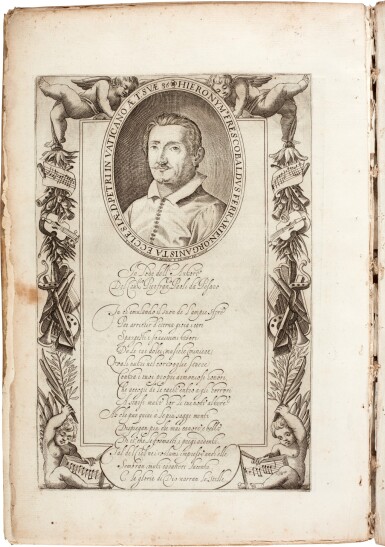Early Music: Rare Music Manuscripts, Printed Music and Books from the Library of Arnold Dolmetsch (1858-1940)
Early Music: Rare Music Manuscripts, Printed Music and Books from the Library of Arnold Dolmetsch (1858-1940)

G. Frescobaldi. Il secondo libro di toccate, canzone, second issue, 1637
Lot Closed
September 14, 01:35 PM GMT
Estimate
20,000 - 30,000 GBP
Lot Details
Description
Frescobaldi, Girolamo
Il second libro di toccate, canzone, versi d'hinni, Magnificat, gagliarde, correnti, et altre partite d'intavolatura di cimbalo et organo, Rome: Borboni, 1637
second issue, 2 leaves, 86 pages, folio (39 x 26.5cm), fine engraved title within an elaborate border showing organ pipes and with the device of Monsignor Gallo, Bishop of Ancona, fine engraved preface (by Blancus, 1615), dedication and frontispiece portrait of the composer by Sas after Jean Saillant, calligraphically engraved music with flourishes and engraved annotations, no plate number, Dolmetsch Library stamp and pencil shelfmark below preface ("II D 9, 2"), illegible Italian armorial stamps to title, dedication and first page of music, manuscript title to upper cover ("Frescobaldi Secondo Libro"), and inscription to spine ("Frescobaldi II"), contemporary vellum boards, first gathering and bifolium containing pp.29-32 nearly detached, browning and spotting to margins, cracked at upper hinge, corners worn
EDITIONS OF FRESCOBALDI'S MUSIC ARE EXTREMELY RARE. WE HAVE NO RECORD OF ANY COPY OF THIS EDITION AT AUCTION FOR THIRTY YEARS.
Frescobaldi's second book of toccatas (which reprints minus the last two pieces those of the first edition of 1627) includes some of the composer's greatest and most celebrated compositions, including the 'Toccata di durezze e ligature', the 'Aria detta la frescobalda' and the famous 'Toccata Nona' - the last being a tour de force, of which the composer notes at the end of piece: "Non senza fatiga si giunge al fine [it is not without difficulty that the end is reached]". Of these works, Anthony Newcomb has noted that "they are among the finest products of the intensity of feeling and freedom of fantasy that were the glories of the Baroque era in Rome...these splendid, grandly rhetorical works have survived the death of their performer-creator and the passing of the short-lived stylistic context in which they were created". More recently, Alexander Silbiger has observed that the toccatas of the second book "are largely responsible for the fascination Frescobaldi has exerted on musicians throughout the ages; their purely musical expression of intense and continually shifting passions has had few equals".
Borboni issued the present work contemporaneously with a fifth edition of the Toccate [e partite] d'intavolatura di cimbalo...libro primo [RISM F 1859], originally published in 1615. They are often found together in institutional libraries, but as Borboni issued both titles with the fine portrait of the composer, they are complete in themselves.
See following lot.
LITERATURE:
RISM F 1867 and FF 1867; TNG A.6a; IT\ICCU\MUS\0060785; TNG, vi, p.830; TNG, ix, p.245
Frescobaldi's second book of toccatas (which reprints minus the last two pieces those of the first edition of 1627) includes some of the composer's greatest and most celebrated compositions, including the 'Toccata di durezze e ligature', the 'Aria detta la frescobalda' and the famous 'Toccata Nona' - the last being a tour de force, of which the composer notes at the end of piece: "Non senza fatiga si giunge al fine [it is not without difficulty that the end is reached]". Of these works, Anthony Newcomb has noted that "they are among the finest products of the intensity of feeling and freedom of fantasy that were the glories of the Baroque era in Rome...these splendid, grandly rhetorical works have survived the death of their performer-creator and the passing of the short-lived stylistic context in which they were created". More recently, Alexander Silbiger has observed that the toccatas of the second book "are largely responsible for the fascination Frescobaldi has exerted on musicians throughout the ages; their purely musical expression of intense and continually shifting passions has had few equals".
Borboni issued the present work contemporaneously with a fifth edition of the Toccate [e partite] d'intavolatura di cimbalo...libro primo [RISM F 1859], originally published in 1615. They are often found together in institutional libraries, but as Borboni issued both titles with the fine portrait of the composer, they are complete in themselves.
See following lot.
